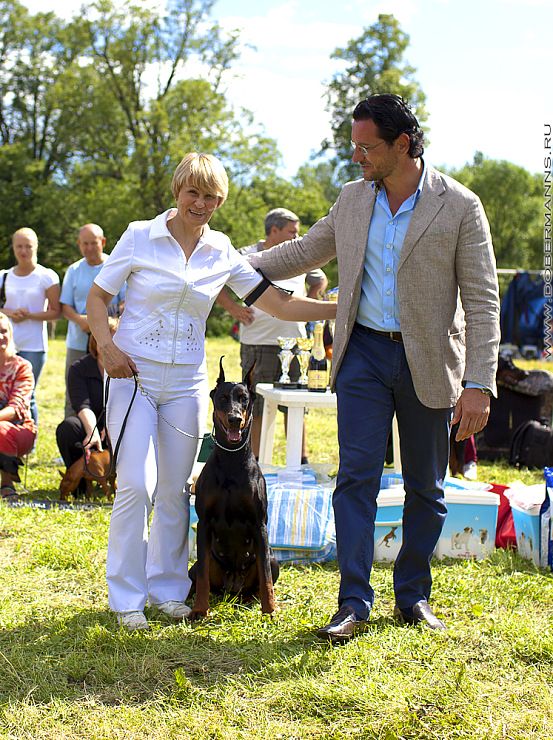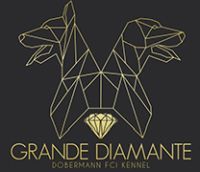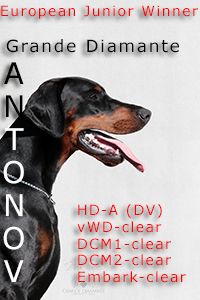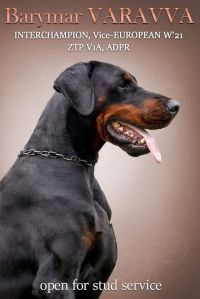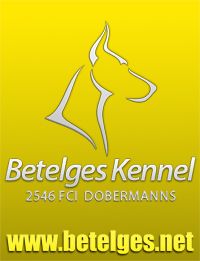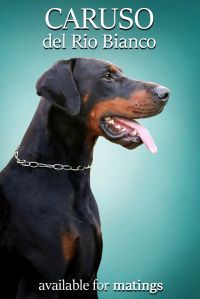August 2013
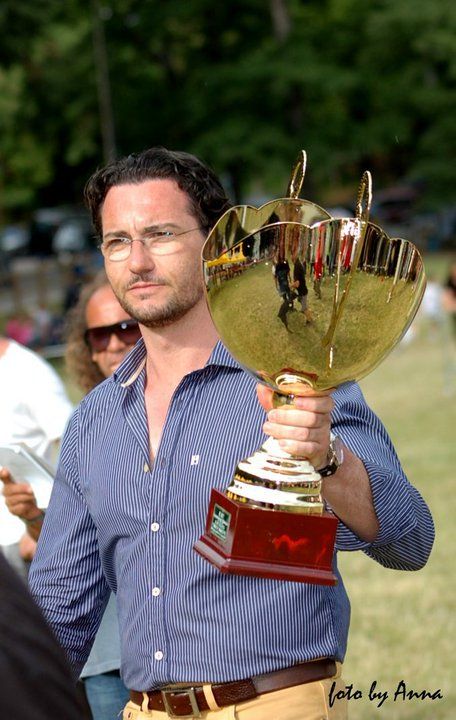
Attilio Polifrone - dobermann breeder and judge
Michal Jakubowsky: As dobermann judge you are known for couple of years but your adventure with dobermanns has longer tradition. How and when all has started?
Attilio Polifrone: My passion with this fabulous breed started when I was only 11 years old. At that time the only scource of information consisted from books and printed magazines. I remember that I was reading immediately every book where I could find any piece of information related to dobermanns. Moreover, I was writing letters to different breeders asking them for photos and details about their dogs. I tried even to call them but I was not taken seriously considering my young age. Few years later in 1988 I got in touch with Margherita Buzzi. I fell in love in photo of Quinn dei Nobili Nati and I had a dream of having a puppy out of this famous at that time Champion. My dream came true and Azur dei Nobili Nati became part of my life. We started to participate at shows. Although we didn't have big successes but on the other hand I had opportunity to meet great dobermann breeders. I remember well Piero Caliandro, Gabriele Prosperi, Giovani Capocasa, Massimo Santini, Antonio di Somma, Antonio Criscuolo, Gianni Chionna, Ernesto Vantaggi, Mauro Favero, Gabriele Cavalleri and obviously the one who noticed me, my enthusiasm, boosted my passion and became my menthor - Pierluigi Pezzano. In 1999 I got permission and started to breed dobermanns. I think that selection with respect and awareness is obligatory to get to know the breed well. I won't forget what my menthor has told me at that day - "that is just a begining and there is a lot to learn in front". I always try to keep it in mind. Today, looking backwards I'm aware of the fact that 25 years has passed since I started my dobermann passion and that time is flying very fast.
M.J: Do you find dobermann an easy breed to judge?
A.P: I don't think that any breed is easy to judge. Everything is described by standard which defines the dog and at least theoretically the one who is closest to standard should win at show. Obviously, all seems to be easy in theory. We assume that knowledge of the standard is based on knowledge of dog anatomy, movement and psychology learned separately from the standard. Judging isn't simple, it's a process which takes time and is not easy to learn. Knowledge why the standard is the way iti is, as well as fundamental understanding of each parts of the standard are crucial for dobermann experts. From my point of view, breeding and living next to dobermann are very important aspects of preparation to become a dobermann judge.
M.J: What is the difference between dobermann judge and all-rounder? How the fact of being dobermann breeder influenced your judging?
A.P: I don't think that such difference exists. The judge who is eliglible to judge many breeds might have a "good eye" for all of them. It is very relative because judging is subjective and has nothing to do with scientific subject. Otherwise it would be just about measuring and assessing but judging has element of art. Success can be reached only when both art and science are combined. Judge must be ready to give arguments and explain why certain dog is better than the other. All judges have own ideal type of the breed, sometimes this type vary from others and this is the reason why we have many opinions. Does the breeding affect the judging? Of course it does and in a very possitive way. No standard covers all aspects of the breed and breeding. Living with dobermann gives you the chance to understand the breed and to judge with respect. There are only good points !
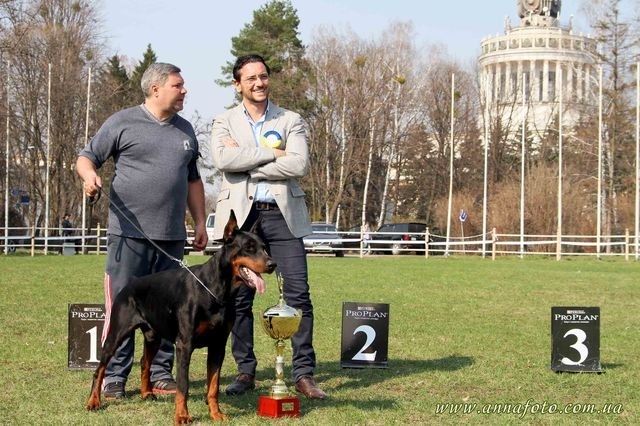
M.J: What is your definition of modern dobermann? On what every judge must pay attention?
A.P: I will start from saying that perfect dobermann is described by standard. For every judge this is obvious because judging has to be according to certarin parameters. However, as I have mentioned before, every judge has its own perfect and ideal type which usually (but not always) is close to general. Many details are judged thanks to careful observation. Keep in mind that over recent 20 years average judge had opportunity to see great breed representatives. Over this period breed had its natural evolution and quality of average dobermann has improved. However, new problems appeared which we have to face with full awareness. I think there is no change in definition of modern dobermann, it is quite simple and I will describe it briefly. It's a dog of perfect beauty, what includes in his base undeniable value. Dobermann is powerful but slim and elegant, he moves with pride. Dog of compact built and always perfect and harmonious proportions. The most important aspect which today seems to be often forgotten is expression. Character of dobermann is social and quiet but at the same time alert and brave. Dobermann is very easy to train, he loves to be a part of the family and always manifests his strong character. Judge has limited time to assess best dog and to make rank list. In the period of few minutes he has to analyze the dog carefully taking into consideration especially his good points rather than the negative ones. It is important to award dogs with harmonious and functional construction, medium-size, compact built and right proportions as well as proper lions part but furthermore expressional head with right propotions. All these features give guarantee for correct and stable movement. Behaviour in the ring is on the first place. Eye of the judge can assess even in limited time self-confidence and balanced character. Last but not least aspect is show preparation. It is not a rare phenomenon that worse dogs but with better show preparation are awarded among better ones with worse handling at scene.
M.J: Do you think that judges should be more critical towards certain aspects of dobermann conformation in order to eliminate defects (e.g wrong bridge-nose, nose colour, size, movement) which became popular in some kennels for whole generations? What judges should do to affect the breeding more by their decissions?
A.P: To be honest, work of the judge besides right judging should be dedicated to give advices for breed improvement. Good assessment is one which has impact on breeding. Never forget that each breed was created for certain reason and to determine its contruction, you must understand its function. At show-ring we can often observe powerfull dogs in terms of their size, who have high topline, long forearms, too steep angles, long heads but too strong jaws. Sometimes we see dogs with right size but too massive built, short forearms, heads with often over-marked characteristics and round, small, too deep settled eyes. There is no doubt that such dogs are not only beyond the breed standard but also won't be able to fulfil their fundamental functions. Dobermann doesn't have to follow any trends or fashion. Dobermann itself is a great combination of balance between power and elegance, always very harmonious in his form and profile based on square. Dobermann head is another separated issue which is often underestimated. Everything starts from the head, head aspects are the most important ones to determine breed type. If we still observe kennels with certain faults which are present in few generations, there might be different reasons to explain this phenomenon. If the breeder is aware of these faults what I personally doubt, perhaps he likes this type of dobermann or he used in his breeding programme few times wrong studs and females. May be even inbreded and he found himself in "black point" in his breeding. In such situation, judge may give advices towards right selection but only when his judgement is accurate. I can say with top certainty that co-operation and humility is needed by both sides. Judge decissions should be not only accepted and first of all understood. When mututal understanding is missing or ecomic aspect starts to be more important, whole process starts to be far more difficult.
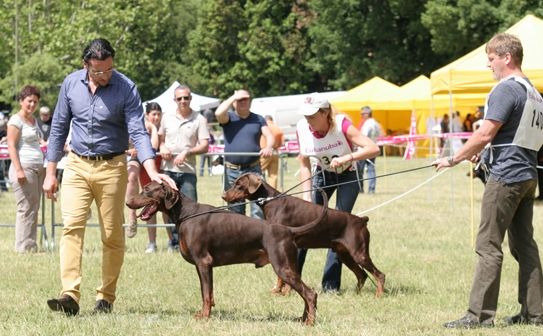
M.J: According to your judging experience across different countries (Finland, Greece, Serbia, Hungary, Russia, Ukraine, Italy), have you noticed common features with dogs from certain country?
A.P: Obviously, within dobermann breed we can notice many common features, especially in dogs who came from same blood-lines with high inbreeding coefficient. It is quite easy to find same good and negative points. However, there is a lack of understanding well-defined standard coherence. Dobermann as other breeds has small genetic base, rather limited genetic resources and in consequence small genetic diversity what obviously has negative influence. It is worth to mention that over last 20 years, 90% of females were mated by not more than 10 stud males and majority of them had same ancestors. Many important kennels (from Belgium, Germany, The Netherlands etc) were closed from known reason - limited genetic potential. On the other hand, many new kennels have appeared in Russia and East-Europe but genetic-base became even smaller what resulted in today's situation when it is difficult to find good dogs who don't have common ancestors in first four generations. All these problems don't have any possitive impact not only on morphology and character but mainly on dobermann health. I think that institutions are obliged to take suitable actions and in some way it is already started. Right selection is very important but in order to succeed, all serious and carefull breeders have to do more efforts in breeding selections. Dobermann future and heritage is in their hands.
M.J: From your observation, what can be noticed in dobermann movement what can't be noticed in standing?
A.P: It's a tradition and organizational purposes that dogs are judged in movement and while they are in standing position. Breed is not judged in its natural movement which is gallop. Judge should be able to determine and judge what type of built is more accurate for dobermann to fulfil its function. Thanks to experience, judgement can be done after first few rounds in dog pace and trot. In dobermann breed, movement is not to confirm what can't be seen when dog stands but to confirm the whole judgement. To make it more clear, starting from head, if there are doubts with topline, neck, shoulders angle, right forearms length, balance of topline and lions part, rear angles - in movement after few rounds, judge will see all what he wants. It's not about race and it's not important if dog is fast and runs with grace thanks to his over-angulation. There is a common opinion that exaggeration is possitive but it is not. All abberations from standards are faults. Often we see dogs with huge temperament, well presented in standing but in movement they lack harmony and balance. Other dogs move their weight on their necks what in most cases is a consequence of their built and can't be hidden even by best handlers.
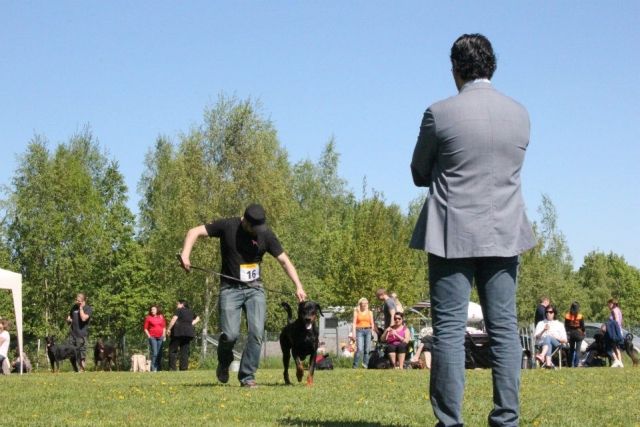
M.J: What is your attitude towards dogs agression in the show-ring? When it can be accepted and when disqualification is a must?
A.P: Dobermann which shows agression in the ring to other dogs definitely has to be punished. When victim of dog agression is judge, handler or show-spectator, dog has to be disqualified. Those are simple rules at shows. However, there are few other issues. Long travels, crowd, limited space, handlers nervousness, going in and out from the cage are doubtlessly stressful situations, especially for these dogs who are less used to show atmosphere or dogs with less balanced characters. Dogs "arguments" (fights) may happen but the one who is always responsible is the handler who doesn't know well enough own dog character and isn't able to read dogs signals. It is very important for handler to have full control under his dog. Dobermann without control can cause serious damage. In order to avoid dangerous situations, judge can take decissions but as I have said before, fault is on the side of handlers who don't have right contact with their dogs. There are also dogs who were born with some deffects and later received poor education. They are result of wrong selection and breeding assessment. In this case, fault is on the side of the breeder. I don't find it responsible to enter such dogs at shows being aware of their problems.
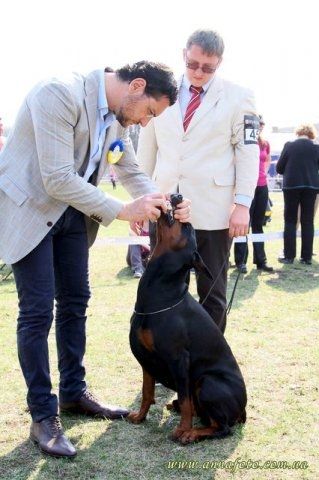
M.J: Could you present your "pyramid" of importance towards dobermann breed?
A.P: Personally, I have a certain list with important features of dobermann but sometimes it happens that I do modifications what depends on circumstances. All points on the list depend on quality of dogs who are present at show-ring. There are some "must" points which have to be respected and which are described in standards of all breeds. The most important is health, physical and menal energy, without them it is out of the question to fulfil breed function and for what dobermann was created. Nowadays, we are in a place where careful genetic examinations have to become obligatory both in terms of inherited diseases and quantity of born puppies. It is one of ways to protect dobermann breed. Except health, it is crucial to understand well the breed function and correlation between they way how the dog looks and its original function for what breed was created. Unfortunatelly, it is often forgotten during judging. I would point out breed history as well - "if you don't know the past, you can't understand the present and can't build the new". Character and behaviour described by standard also can not be overlooked.
In order to give proper answer to your question, assessment of all parts is divided into head, body and legs. My education as a judge tells me to rate certain features of head and expression. Nice head is one which is in harmony with the rest, proportional, has right dimmensions and adds coherence to whole body. I do judge total harmony which accordingly with size creates natural combination of power and elegance. Important features which let to reach ideal dog are compact body, short and strong lions, short and horizontal croup with sharp angles and coat of right structure, length and markings. All these gives description of perfect dobermann who basically is a typical one without exaggerations or over-marked features.
M.J: What tips given to you by your menthor Dr. Pezzano are the most memorable for you?
A.P: Pierluigi Pezzano had huge impact on my education as a judge. We know each other since 1988 and for many years I had this great ocassion to spent time with him and his family. Today, I have to admit with big regret that lack of time doesn't let me to take advantage from his knowledge. It is well-known for everyone who has interest in dogs and dog-shows that Pezzano is one of the greatest experts in the world. I learnt a lot from him and I still learn more anytime we meet. What is the most memorable? Good question. I can say - everything, although I know it's a truism. Let me give some examples - detailed and careful dog description, remarks on correct built in relation to breed function, first look to good points and only next to faults, different ways to notice lack of dog self-confidence in the ring, complete understanding of standard and skill to use it starting from head and finishing on the tail... many other tips which I always keep in mind and which made me as a judge in show-ring.
M.J: What will be the impact on dobermann breed after standard is changed (undocked tail and uncropped ears)?
A.P: Since it is forbidden to crop and dock in many countries, our breed suffer from it and lost population. I think that this issue deserves deep analysis and we need to ask right questions before we will blame decission to forbid cropping and docking. I would ask - does our dobermann is healthier and lives longer? Is he well and carefully assessed at shows? Are all criteria well selected? Does the dobermann-clubs do everything what they can to protect and promote dobermann? Everyone should ask himself these questions and try to asnwer. In my opinion, change of standard won't have negative impact on the breed. There are few of us and there will be less and less if some kennels get closed and demand on dobermanns will decrease. It may happen that we will do step back instead of doing step forward.At this moment, we should focus on health and try to eliminate with great efforts genetic diseases which limited demand on dobermanns.
